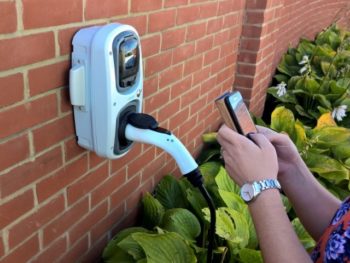All new homes and buildings such as supermarkets and workplaces will be required to install electric vehicle charge points from next year, under newly announced legislation.

Up to 145,000 extra charge points will be installed across England each year thanks to these regulations, which are set to pass through Parliament before the end of 2021 and come into effect six months later.
It will mean drivers can buy new properties already equipped for the 2030 ICE ban, while ensuring new shops and workplaces across the UK are also ready for the switch.
And buildings undergoing largescale renovations that leave them with more than 10 parking spaces will also be required to install electric vehicle charge points.
The plans have been revealed by the Prime Minister today (22 November) as the Government revealed it will also introduce simpler ways to pay whilst travelling, such as contactless, at all new fast and rapid charge points, on the back of an industry consultation.
The Department for Transport had said two years ago that it had expected the EV charging industry to develop a single roaming standard that it would allow drivers to use any public charge point via a single contactless payment – and that it would intervene if necessary. It had also announced a consultation on fitting all new-build homes with a charge point at the same time.
The new plans for legislation have been announced ahead of the Prime Minister’s speech today to the CBI annual conference, where he’ll set out that public–private sector work on everything from electric vehicles to clean power can help the UK create a ‘first mover advantage’ in the biggest transformation of the global economy in 200 years. The Government has also confirmed today nearly £10m in funding for a first-of-a-kind new hydrogen project in the UK’s largest onshore windfarm near Glasgow.
The AA said the new laws on charge points would “supercharge the electric vehicle revolution”.
Edmund King, AA president, commented: “With the 2030 ban on the sale of new petrol and diesel cars getting ever closer, it is essential that we gear up now to ensure that we future-proof our homes and buildings for the EV revolution.
“The majority of EV drivers in the future will do most of their charging at home, so it is essential that new homes are equipped to help this transition. For those without off-street parking, it is also crucial that we see more charging posts on-street, and in offices and supermarkets.”
Also applauding the action on contactless payments, King went on to say: “The prospects for the EV revolution are looking good with better and more affordable cars coming to the market with increased range and a more reliable charging infrastructure being developed. All this should help bring power to electric drivers.”
Lex Autolease also commented, saying that the announcement was another strong signal of intent from policymakers to position the UK as a world leader in electrification.
Meryem Brassington, electrification propositions lead, outlined: “As momentum continues to shift away from petrol and diesel, investment in the UK’s charging infrastructure is mission-critical if we are to deliver on the ambitious Road to Zero targets.”
She added: “By ensuring the product supply and supporting charge network is in place, we can continue to help individual drivers and businesses accelerate their transition towards an electric future.”
And LeasePlan said the news was long overdue.
UK managing director Alfonso Martinez remarked: “Despite being one of the top three countries in Europe for EV readiness, the UK still lags behind in terms of charging infrastructure.
“This hasn’t stopped the rapid rate of adoption – 20% of our vehicle orders now are for EVs compared to 1% only a few years ago – but it has created a misconception amongst drivers that EVs are a niche product rather than the right choice for everyone.
“By making charging part of every new home, the Government is removing a major barrier stopping drivers from making the switch, while providing the incentive that the country urgently needs to deliver on its net zero goals.”

